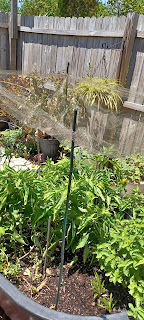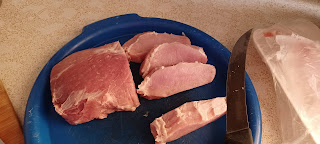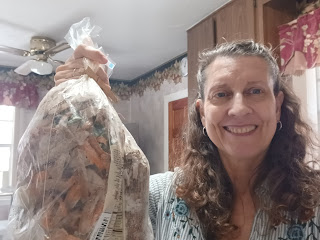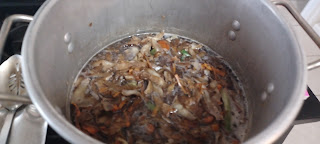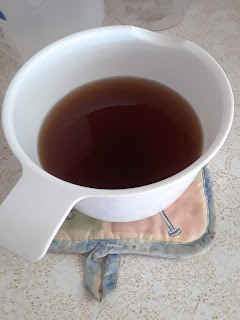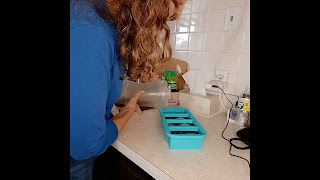A garden update for June 2022. I live in Zone 9b, Florida, have an urban, container garden.
The garden is going well this year. After taking out the hot tub and putting two raised beds in the space, there is a lot more room to grow things this year.
Which is good because my husband made a trip to Home Depot in March and came back with six bell pepper plants and six tomato plants of different varieties! The peppers went in one of the beds, while I continue to put tomatoes in smaller containers so they can be moved around. They don't do well under the worst of the Florida sun and I try to find places with a bit of shade for them.
Here's what the garden looks like in June 2022.
You can see much of the garden in this photo. In the raised bed nearest the camera, the flowering plant hanging over is a penta. There were two of them and they outgrew the space, so I moved one to the other raised bed.
In the tomato cage are a couple of everglades tomatoes. You may not be familiar with that variety. They are very small - smaller than a cherry tomato - but they do well in the Florida heat and humidity. I planted the seeds last fall, but they didn't germinate until earlier this year. I often pick 6-8 a day and find them a fun snack or addition to a salad.
There is also some celery in there. I planted it last fall and it did not do much, and I am shocked it has not completely died in the heat. Hasn't gotten big enough to really do anything with other than add flavor to cooked dishes, but I still have seeds and will try again this fall.
At the far end green beans trying to grow. I've had pretty good luck growing them in containers, but the ones I planted earlier this year in the raised bed did not do well. I realized that in this size raised bed, they need more water. That has helped, but I believe I need to get some shade cloth for them as well.
The container with the blooming flowers next to the wall is Purple Opal Basil. I received the seeds free with an order from
Baker Creek in 2020 and have been thrilled how well it grows here.
On the other side are containers with bell peppers I grew from seed, turmeric, amaranth with some of the tomatoes my husband bought, and a couple of the hanging baskets that were on the ground for a good watering.
Between the beds is a container with New Zealand spinach. This is not a true spinach, but a green that does grow well in my climate. I try to sow seeds every month or so to enjoy these in salads and on sandwiches. You can't tell, but there are also three loquat trees in there. I sprouted the seeds this spring, and am going to move them to larger containers.
Loquat is also known as Japanese Plum. The fruit is smaller than most plums, and has several large seeds in it. It blooms in January and the fruit is ready to pick in February and March.
I sprouted a seed about five years ago. That tree is over five feet tall and I am looking for a place to plant it in our yard.
Close up of a bell pepper on one of the plants I grew from seed.

The other raised bed is where I planted the six pepper plants my husband bought. They have done fantastic! The first peppers I harvested were from the plants I grew from seed, but these have surpassed them. We are about to the point of calling friends and asking if they want any, as well as freezing some. We made stuffed peppers last weekend using peppers we grew. Very satisfying.
I also grow purslane in that bed, another green I add to salads and put on sandwiches, as well as calendula and a few coreopsis that grew from seeds left from last year's plant.
And, I have peanuts growing in there! This wasn't what I had planned, but when neighbors put out peanuts for the squirrels, who then bury them in my garden, what can I do? If the peanut sprouts, I put it in the bed. I did this last year in a couple of small containers and actually grew peanuts.
Wouldn't it be fun to make my own peanut butter from peanuts I grew?!?
One of the tomato plants my husband bought. It has done really well, and there are 8-10 tomatoes on there. I have already harvested a few as they have begun to turn color. As you can tell from the leaves, it is getting stressed in the Florida summer sun. Once I pick the tomatoes on there, I'll pull the plant.
NOTE: When should you harvest tomatoes? I always thought you should leave them on the vine until they are red and fully ripe. As tomatoes began turning this year, I lost a number of them to some critter or critters who would peck a hole or take a bite. This was only in the containers that had cages on them, so I think they were using the cage to get to them.
To get more of my harvest, I began to pick them as soon as they were obviously changing color and let them ripen in front of a window.
Then I came across this
Reel on Instagram on the best time to pick tomatoes. Turns out, I was doing the right thing!
Who knew vine-ripened was just a marketing ploy?
Along the west fence are (from the back) lemongrass, sage, moringa, and two containers with sweet potatoes.
Along this side of the fence are mainly ornamental and flowering plants - cannas, aloe vera, geraniums, and more hanging baskets of airplane plants.
Summer has definitely arrived here. In fact, it arrived in mid-May, which is early for us. So far, most things are hanging in there - the bell peppers thrive in this weather - but the next month will see the last of these tomato plants. Hopefully the green beans will come through. I'm going to buy some nylon netting to use as a shade cloth during the heat of the day. Once I set that up and see how it works, I'll have a post on that.
How is your garden growing this time of year?
Have you downloaded my free Plant Information Sheet? Print out as many copies as you need so you can record the growing, harvesting, and using information for everything you grow. Click here to learn more and get your copy.



